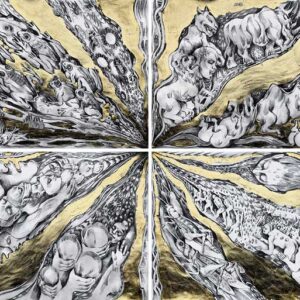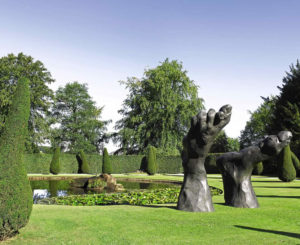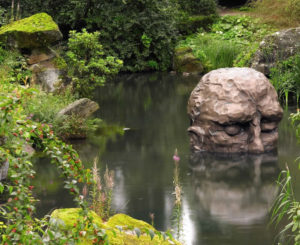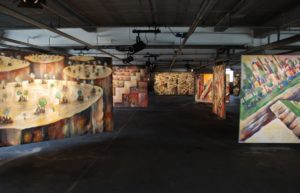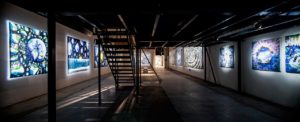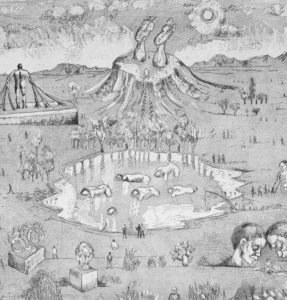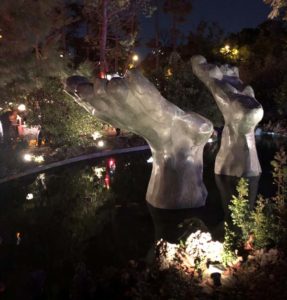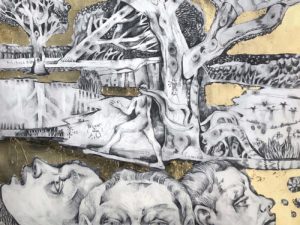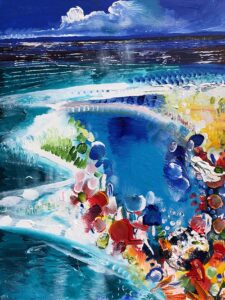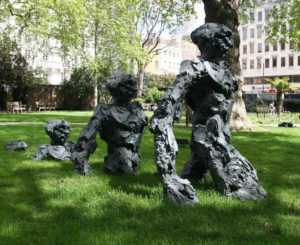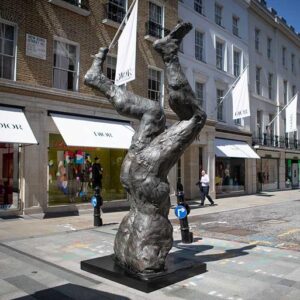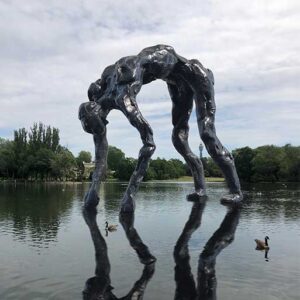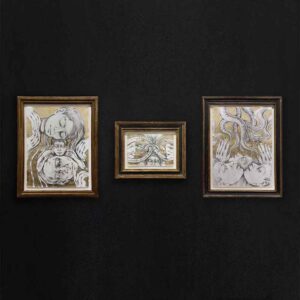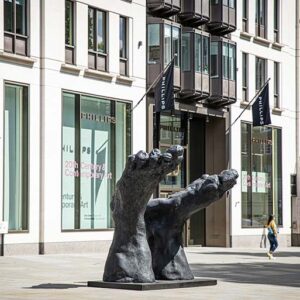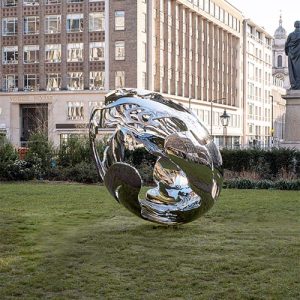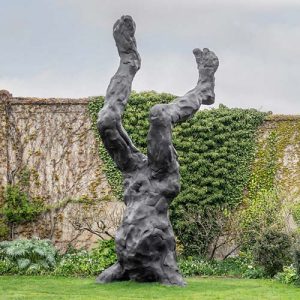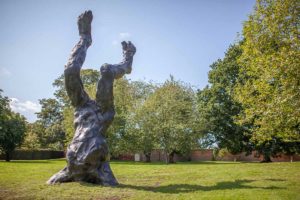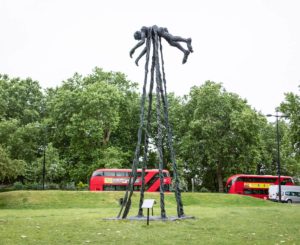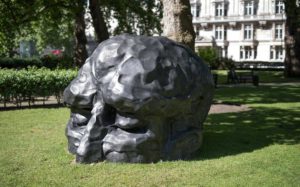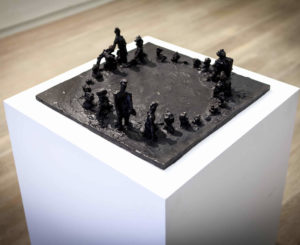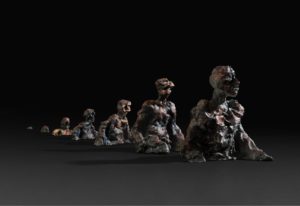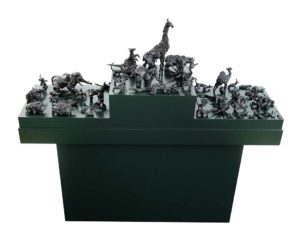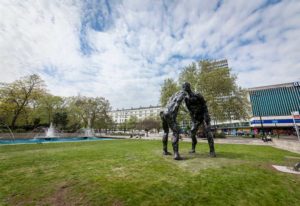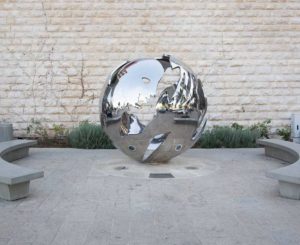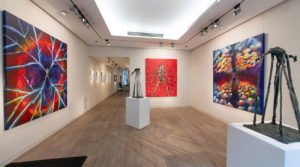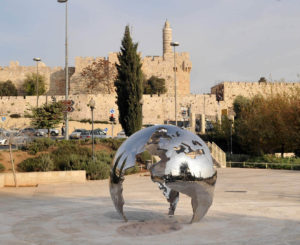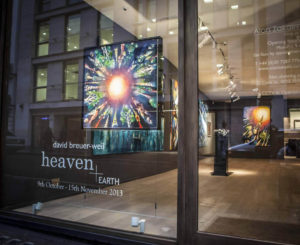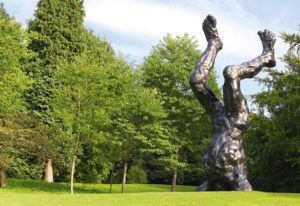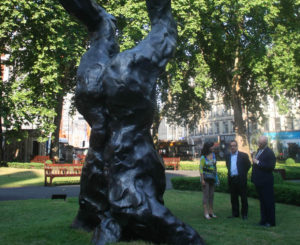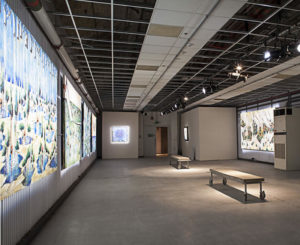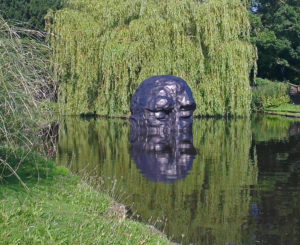This virtual exhibition, corresponding with Frieze London 2022, introduces a group of major new paintings executed during the period of the pandemic, lockdown and since. These works are searingly relevant to recent times, iconic images of the era of Covid, lockdown and the invasion. Surprisingly, few significant art works have dealt head on with the unforgettable motifs of the last 30 months.
During the period between the two lockdowns National Galleries were open if you booked online for slots to see the collections. A visit to the Duveen Galleries inspired a major installation of new paintings that are a powerful expression of the current world situation. Breuer-Weil says I went to the National Gallery in London many times as well as Tate Britain. In many cases I virtually had the galleries to myself as there were so few people. Both the National Gallery and Tate Britain inspired new works at that time.
Walking through the Duveen galleries at Tate Britain what I can only describe as a vision enveloped me. I imagined the whole space filled with vast paintings that encapsulated this extraordinary time, colossal cave paintings for the era of Covid, brimming with symbols of our life at this time and the unprecedented universality of this experience, with the whole world going through the same thing at this time. A new language and new symbols had been born and I wanted to express that in an appropriate manner. There were large obstacles. I knew the Tate would likely not agree to show them. They required a great deal of canvas, paint and expense. Lastly, there was the massive artistic challenge. Despite all of these very clear reasons not to proceed I ordered over sixty square metres of canvas and immediately got to work in the most intense period of creativity I have ever experienced. The installation comprises around 17 monumental canvases and can fill the entire space that inspired them.
Selected paintings:
BUBBLE
2020
acrylic on canvas
200 x 370 cm
Bubble is a map of the world turned on its side. Looking closely the viewer can see that each country is composed of thousands of bubbles containing families or single figures. This refers to the notion of isolated bubbles of people during the lockdown, support bubbles. The bubble is used to create a mesmerising image of literal bubbles with reflections, with countless figures contained inside them and spanning the whole world. It is intended to be a magical image of hoped-for equality in the face of an existential threat.
With all of these works I intended for them to operate on both the macro and micro level. For them to be bold compositions with immediate impact, but also to be filled with intense detail and images of the myriads of individuals caught up in this moment in time.
INVASION
May 2022
acrylic on canvas
overall: 390 x 777cm
Four panels, each 195 x 388.5 cm
Painted in May 2022, this powerfully evocative work is a reaction to recent events in Ukraine and is inspired by prior art historical anti-War paintings including Picasso’s Guernica, and the canvas is deliberately of identical width to that masterpiece -777cm – to show that current events are comparable to the situation in 1937 when the Basque town was bombed by the Luftwaffe.
A mesmerising and shattering explosion of colour (yellows and blues, but also searing reds and purples) the viewer is dragged into the vortex as a vast force invades a large landscape with a city on the horizon. There is large array of potent symbols that can be interpreted at different levels. People, tanks, animals, attack vehicles and baying dinosaurs can be seen stamping into a territory. At the same time crowds flee the city, running, escaping in cars and coaches, whilst in the opposite direction long lines of vehicles and invaders descend upon this location. Amongst the invading crowds are visible the open minds of those who planned this attack. In one mind a nuclear explosion can be seen. Still only a possibility, this is a terrifying thought. Other minds are filled with fire, or with papers: the ideas, histories, or grievances, real or imagined, that often spark off such events. Throughout the composition are fluttering newspapers and sheets of paper, the drama of news generated by this event. In the vast skies above the city can be seen a combination of real and psychological images: attack helicopters, planes, and missiles, but also angelic presences, threatening human forms, predators, vampires. Human faces are transformed into bubbles, a symbol of human fragility. The human costs, both physical and mental of recent events are played out on this huge canvas. At the centre are images of two mothers overseeing the whole scene: their children, as always, are the victims as the pain of the mother is the archetypal image of loss and it is always mothers on both sides who pay the price of conflict, like a contemporary Pieta. There are hundreds of significant details in this composition. Near the tower blocks of Kiev can be seen the outline of the ravine of Babi Yar and other monuments to genocide during World War II, some of which have been damaged in the fighting. There are several towers, these are statues protected by sandbags, one of the cultural leitmotifs of the invasion-the statue covered up. A man writes on the ground, one of the countless personal stories that will be told about the invasion whilst a mother clutches her child as she flees the country.
Breuer-Weil comments Many of the unforgettable images of this war came together and prompted me to paint this highly ambitious work as an act of protest. Historical moments supercharge artists to do something that takes them by surprise. I don’t really know where this came from, this urgent need to paint a work of this scale and complexity. But it came together in a kind of whirlwind of inspiration and the composition reflects this.
Many of my ancestors came from Ukraine, including Rabbi Saul Katzenellenbogen from the Lviv Oblast, Ukraine, Malka Luria, Lviv, Dreizel Miriam Schrenzel and Rabbi Nachman Schrentzel, Lviv oblast. They were well known scholars and their descendants migrated as far afield as Krakow, Mattersburg and Vienna. To me the Ukraine is therefore deeply imbedded in my mind as a place of origin, but also the site of some of the worst outrages in history notably Babi Yar. Current events bring back to mind past and present conflicts, both the worst and best of humanity, the dinosaurs of the past have been shockingly resurrected in the form of empires and a rape on a colossal scale. Artists of today cannot ignore this.
LOCKDOWN
2020
acrylic on canvas
central panels: 200 x 370 cm
outer panels: 200 x 300 cm
overall: 400 x 970 cm
Breuer-Weil comments: I wanted to make an iconic image of the unprecedented idea of lockdown, of thousands, indeed millions of people contained in their own boxes, part of an immense international situation but nevertheless paradoxically alone or in small groups, engaged in every kind of different activity. I painted a limitless field of spaced-out dwellings, small boxes, as a triptych. In each box there is great amount of detail, individual realities. One person talks on zoom, the great connecter of now. In one box a person wordlessly watches the killing of George Floyd on screen. In another a person runs on a running machine. One eats, another reads, another paints, another argues, another prays and others think, dream and drift away in fantasies of travel and exploration. There is great separation and loneliness. But paradoxically there is also great rhythm, connection, belonging and order, kept separate, but communicating in different ways. Millions of tiny islands of life. Above the three canvases are three further canvases. These mirror the ones below, like shimmering stars in a night sky. My idea was that these lockdowns on different sides of the world transcend space and time-zones. The upper three canvases are also fields of locked-down individuals and families mirroring the ones below as if on the other side of the globe.
How often does the entire world experience the same thing at the same time? Although caused by the great tragedy of the pandemic that had, at this stage, cost at least a million lives, never has there been such unity based on shared experience. That is a paradox that I wanted to paint, and it required working of a large scale. Overall, this painting Lockdown is almost ten metres long and four metres in height. I intended for each of the six parts of the canvas to function as a work on its own but also to belong to the whole, just like each of the boxes in the composition that contains its own world of activity. I have also made reference to iconic works from Tate Britain’s collection. Spencer’s Resurrection comes to mind. I have been walking often past the place where Spencer painted this work, at the Vale of Health in Hampstead, and have been influenced by that spot, its lake with reflected trees and buildings. I thought that now is the time to embark on an ambitious large-scale canvas that shows all people unified by common experience. With Spencer it may be mortality, but I wanted to ponder the image of a whole universe locked down in their own units. Alone but together.
PANDEMIC
2020
acrylic on canvas
central panels: 200 x 370 cm
outer panels: 200 x 300 cm
overall: 400 x 970 cm
The second vast canvas is like a colossal sunburst, radiating centrifugal energy from a midpoint. I wanted to paint this invisible force that was taking over the world. How do you paint a force as powerful as radiation, as overwhelming as a tiny invisible particle that transforms everything? How do you capture a white light that is hotter and brighter than anything visible in nature? In this regard I was helped by the collection of Turners in the Turner Bequest at Tate Britain, especially images of light and large central sun-like forms at the centre of Turner’s compositions. How do you paint a force that humans are utterly helpless against, no matter how powerful they may think themselves to be? How do you humanise that image? The central image is a sphere reminiscent of the Covid, but all of its elements are made of human beings. This contagion spreads outwards like an unstoppable force and into large heavens in which people undergo transformations and mutations. I experiment with differing forms and shapes, there are extremely bizarre evolutions taking place to the human form and micro-organisms, a force of nature way beyond our powers. This painting reflects this great force.
It took a great amount of physical energy to produce the work that is the same size as Lockdown, and its partner painting, conceived to hang exactly opposite. The two paintings share a similar colour range, from intense burning red to the cobalt blues and ultramarines of the night sky and universe beyond. White light, shadow, and mists abound, allowing me to experiment with different densities of paint from the thickest impasto to barely perceptible washes. All of these elements reflect an intense personal experience of both the Lockdown and Pandemic itself in many different ways. The virus itself takes you away from this world into a metallic, rasping, fearful, hallucinogenic alternative reality.
NEW NORMAL
2021
acrylic on canvas
200 x 400 cm
I had been studying the creation of the Last Supper by Leonardo da Vinci, in particular the perspective and the presence of expressive figures in space. I pinned all the bubbles to a powerful receding perspective, possibly an unconscious idea that we were moving out of this period of living in separate units. In some ways this painting completed what I had started with my large Lockdown painting some months earlier.
THE QUEUE
2022
acrylic on canvas
200 x 330 cm
I painted a painting of the queue that I saw at Westminster Abbey, people waiting to see the Queen lying in State. What a subject, thousands of people patiently standing in line, another unforgettable image of our times, redolent with meaning and a great subject, making me think of John Milton’s line “they also serve who only stand and wait”. I concentrate on the light behind the figures and the shadows thrown by crowds. I’m struck by an image that seems to epitomise these years: thousands of people patiently waiting in line out of love for somebody that almost all of them never knew. I need to paint this. I throw down yellow, orange, red, mauve and blue pigments on the canvas. The queue is in a zigzag form, giving the composition a rush of dynamism. The painting is a great experiment in colour, how it merges and creates swathes of mood as the people pass through hours. Light and shadow is crucial. The shadows give the colours a different dimension, and the figures are both real and ethereal because of their shadows.






